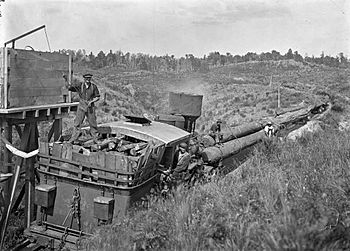Mangapehi River facts for kids
For the sawmill area of Mangapehi see Ellis and Burnand#Mangapehi
Quick facts for kids Mangapehi River |
|
|---|---|

Climax steam locomotive with a load of logs en route to the Ellis and Burnand sawmill at Mangapehi
|
|
| Country | New Zealand |
| Physical characteristics | |
| River mouth | Mokau River |
| Length | 25 km (16 mi) |
The Mangapehi River is a river located in the southern part of the Waikato region in New Zealand. It's a natural waterway that plays a role in the local environment.
Contents
About the Mangapehi River
The Mangapehi River starts its journey near a place called Benneydale. From there, it flows towards the northwest. After traveling about 25 kilometers (15 miles), the river eventually joins the Mokau River. This meeting point is about 10 kilometers (6 miles) southwest of a town called Te Kuiti.
Where is the river located?
The Mangapehi River is found in the Waitomo District, which is part of the larger Waikato region in New Zealand. This area is known for its beautiful natural landscapes and unique features. The river helps shape the land it flows through.
What's in a name?
The name Mangapēhi has a special meaning. According to the New Zealand Ministry for Culture and Heritage, the name translates to "stream of trouble." This interesting name might hint at challenges or difficulties people faced when traveling or living near the river in the past.
A River's Journey
The Mangapehi River begins its path in the hills near Benneydale. It then winds its way through the landscape, heading generally towards the northwest. Rivers often act like natural highways, connecting different parts of a region. The Mangapehi River is one of many rivers that contribute to the larger Mokau River system.
History and Connection to the Land
Rivers like the Mangapehi have often been important for local industries and communities. The image in the infobox shows a steam locomotive carrying logs to a sawmill in Mangapehi. This suggests that the river area was once important for the timber industry. Logs were likely transported using the river or nearby railways, showing how natural features like rivers are connected to human activities and history.
Images for kids


